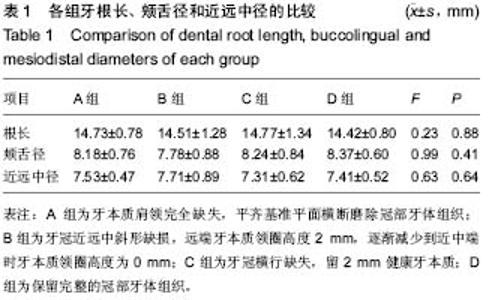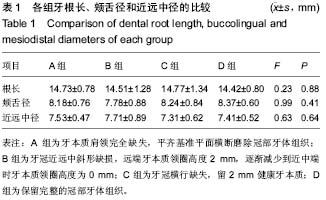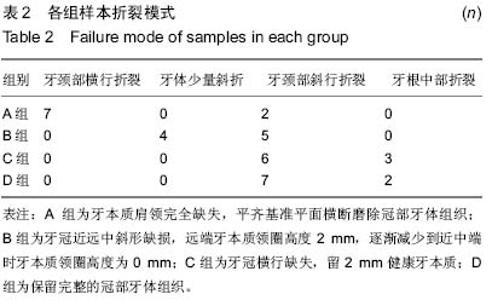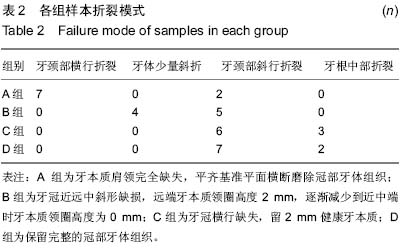| [1] Caputo AA,Standlee JP.Biomechanics in clinical dentistry. Chicag:Quintessence,1987:185-203.
[2] 唐震宇,蒋柏荣,蒋士勇,等.玻璃纤维桩修复残根残冠的效果[J].中国组织工程研究,2010,14(51):9687-9688.
[3] Eraslan O,Aykent F,Yücel MT,et al.The finite element analysis of the effect of ferrule height on stress distribution at post-and-core-restored all-ceramic anterior crowns.Clin Oral Investig.2009;13(2):223-227.
[4] Kri?nar I,Jevnikar P,Fidler A.Effect of Er:YAG laser pretreatment on bond strength of a composite core build-up material to fiber posts.Lasers Med Sci. 2015;30(2):733-740.
[5] 陈吉华,李伟,郑亚萍.不同弯曲度对牙科纤维增强复合材料桩钉性能的影响[J].中华口腔医学杂志,2006,41(6):331-332.
[6] 胡江,何惠明,王竞博,等.光照时间对自制光固化型牙科玻璃纤维桩弯曲强度影响的实验研究[J].美容医学,2009,18(8): 1155- 1157.
[7] 镇荣军,蔡同道,吴细霞.玻璃纤维桩在恒前牙断冠再接中的临床疗效观察[J].口腔医学研究,2011,32(5):435-436.
[8] 常志明.玻璃纤维桩与金属桩核修复牙体缺损的比较[J].中国组织工程研究,2013,17(29):5309-5315.
[9] Valdivia AD,Raposo LH,Simamoto-Junior PC,et al.The effect of fiber post presence and restorative technique on the biomechanical behavior of endodontically treated maxillaey incisors: an in vitro study.J Prosthet Dent.2012;108(3): 147-157.
[10] Salameh Z,Ounsi HF,Ahoushelib MN,et al.Effect of difierentonlay systems on fracture I.esistance and failure pattern ofendodontieally treated mandibular molars restored with and withoutglass fiber posts.Am J Dent.2010;23(2): 81-86.
[11] Fredriksson M,Astback J,Pwnenius M,et al.A retrospective study of 236 patients with teethrestored by carbon fiber–reinforced epoxy resin post.J Prosthet Dent.1998;80: 151-157.
[12] Ferrari M,Goracci C,Sadek FT,et al.An investigation of the interfacial strengths of methacrylate resin-based glass fiber post-core buildups.Adhes Dent.2006;8(4):239-245.
[13] Bergman B,Lundquist P,Sjogren U,et al.Nonlinear finite element analyses: Advances and challenges in dental applications.J Dent.2008;36:463-471.
[14] 马永刚,邓旭亮,安靖,等.三种复合树脂与玻璃纤维桩的微拉伸强度研究[J].口腔颌面修复学杂志,2009,10(3):170-172.
[15] 聂二民,张春元,陈霞云,等.残根牙体剩余量对纤维桩核全冠修复体力学性能的影响[J]. 口腔颌面修复学杂志,2009,10(1):5-8.
[16] Ferrari M,Cagidiaco MC,Goracci C,et al. Long-termretrospective study of the clinical performance of fiber posts.Am J Dent.2007;20(5):287-291.
[17] Abo El-Ela OA,Atta OA,El-Mowafy O.Fracture resistance of anterior teeth restored with a novel nonmetallic post.J Can Dent Assoc.2008;74(5):441.
[18] 吴大明,吴友农.上颌第一前磨牙的形态学研究回顾[J].口腔生物医学,2010,1(1):46-48.
[19] Cohen S,Blanco L,Berman L.Vertical root fractures: clinical and radiographic diagnosis.J Am Dent Assoc.2003;134(4): 434-441.
[20] Gutmann JL.The dentin root complex:anatomic and biologic consideration sinrestorin,endodontically treated teeth.J Prosthet Dent.1992;67(4):458-467.
[21] 王惠芸.我国人牙的测量与统计[J].中华口腔医学杂志,1959,7(3): 149-155.
[22] 胡江,何惠明,王竞博,等.光照时间对自制光固化型牙科玻璃纤维桩弯曲强度影响的实验研究[J].美容医学,2009,18(8): 1155- 1157.
[23] 肖洁,何惠明,周冰,等. 不同角度桩核冠三维有限元模型的建立[J].临床口腔医学杂志,2006,11(2):25-27.
[24] Guzy GE,Nichols JI.In vitro comparison of intact endodontically treatedteeth with and without endo-post reinforcement.J Prosthet Dent.1979;42(1):39-44.
[25] Dimitrouli M,Geurtsen W,Lührs AK.Comparison of the push-out strength of two fiber postsystems dependent on different types of resin cements.Clin Oral Invest.2012;(16): 899-908.
[26] 迪丽努尔•阿吉,努力帕•阿布来.纤维桩不同长度对纤维树脂桩核修复体抗折能力的影响[J].口腔医学研究,2012,28(9): 907-910.
[27] 高士军,李懿,孙世杰,等.不同树脂核材料影响纤维桩核整体抗折强度的比较[J].中国组织工程研究,2014,18(21):3304-3309.
[28] Naumann M,Preuss A,Rosentritt M.Effect of incomplete crown ferrules on load capacity of endodontically treated maxillary incisors restored with fiber posts, composite build-ups, and all-ceramic crowns: an in vitro evaluation after chewing simulation.Acta Odontol Scand.2006;64(1):31-36.
[29] 李群,王邦康,王春明.牙本质领对桩冠修复牙牙体应力的影响三维有限元研究[J].北京口腔医学,2003,11(3):128-130.
[30] 陈新民,牛林,吴小红,等.残冠牙体余量对核桩冠桩根联合体水平承载力学性能的影响[J].口腔颌面修复学杂志,2005,6(4): 268-274.
[31] Assif D,Bitenski A,Pilo R,et al.Effect of post design on resistance to fracture of endodontically treated teeth with complete crowns.J Prosthet Dent.1993;69(1):36-40. |



